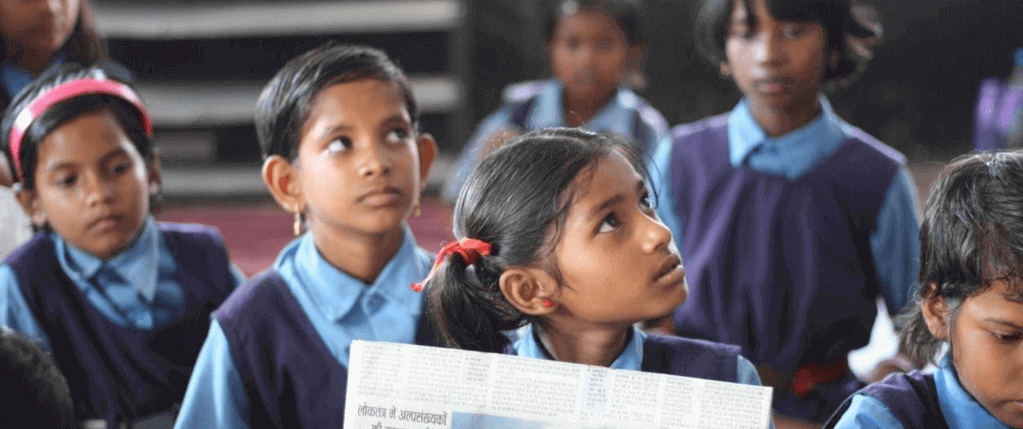A New Approach To Understanding Malnutrition In India

Researchers use a new technique to evaluate under-nutrition, micronutrient deficiencies and obesity in children. – Photo by Jaikishan Patel
One of the greatest ironies that exist in India today is found in the food we eat. While the agricultural production was over 285 million tonnes in 2018–19, amongst the highest globally, the country also has one-third of the total malnourished children in the world. More than half the deaths of children under five years is due to under-nutrition. Today, malnutrition among children in India has become a three-pronged problem of under-nutrition, micronutrient deficiencies and growing obesity.
Over the years, India has implemented several policies for improving child nutrition. One such initiative is the National Nutrition Mission (NNM) or the POSHAN Abhiyaan launched in 2018 intending to reduce the prevalence of low birth weight, anaemia and stunting in children below the age of 6 by the year 2022. Along with implementing the policy, however, it is also important to monitor its effectiveness so that it can be improved and updated. In a recent study, published in the International Journal for Equity in Health, researchers from the Indian Institute of Technology Bombay (IIT Bombay) have used a new ranking technique called MANUSH to understand the triple burden of malnutrition in the country.
Several health and nutrition indices — such as SDG Index, Food and Nutrition Security Analysis and the Niti Aayog‘s Health Index — that reflect the effectiveness of the policy have been developed to help decision-makers in policy planning as well as resource and fund
allocation. A closer look at these indices indicates the prevalent use of a linear aggregation methodology or the method of simple averaging. In this method, the performance of the policy under different criteria is simply summed to calculate a composite index, which represents the multiple indicators. But, this effectively masks the underperformance of some indicators and can cover up a lopsided growth.
―In the usual composite index based on the arithmetic mean, underperformance in one dimension, say wasting, can get masked through the improvement in other dimensions, say stunting,‖ says Ayushi Jain, a senior researcher involved in the study from the Centre for Technology Alternatives for Rural Areas (CTARA), IIT Bombay. ―Even geometric mean method of composite indexing, which has been used in the calculation of the Human Development Index (HDI), does not ensure this, since a country‘s progress on the economic front can hide its sluggish performance in, say, healthcare,‖ she adds.
To overcome the limitations of the above methods, the researchers applied the MANUSH technique for calculating the index. ―Malnutrition is a multi-dimensional problem and has different facets such as stunting, wasting, underweight, obesity and even anaemia due to iron deficiency,‖ says Prof Satish Agnihotri of CTARA, who is part of the study. The MANUSH technique ensures that, in addition to considering the effect of individual factors on any index, relationships between different factors are also taken into account. The index would impose a penalty if the implemented policy neglected one aspect while bettering the others.
For instance, in the case of HDI, MANUSH would require that a poorly performing indicator such as healthcare needs to improve at a faster rate compared to a well-performing indicator such as economic growth so that the overall gap between different indicators reduces and the development is more balanced.
In the current study, the researchers considered four parameters to calculate the index for the triple burden of malnutrition — the proportion of stunted and wasted children which reflects undernutrition, the proportion of anaemic children indicating micronutrient deficiency, and obesity indicated by a median weight-to-height ratio of over two times that of the WHO child growth standards. They computed the MANUSH-based index scores, ranging from 0 to 1, using nutrition and family health data collected from all states and union territories covered under the National Family Health Survey 3 and 4 (NFHS 3 & 4) carried out in 2005–06 and 2015–16, respectively, as well as the Comprehensive National Nutrition Survey (CNNS) conducted in 2016–18. Lower the scores, lower is the burden of malnutrition.
Apply for a PhD at IITs
Apply for a PhD at IITs — the best technology institutions of India
The researchers further categorized the states and districts into five classes — low, moderate, serious, alarming and extremely alarming — based on the severity of malnutrition according to the MANUSH scores. ―Categorization of states and districts on severity scale is loosely based on the Global Hunger Index’s categorization of countries on hunger scale, as it is widely accepted and understood by policymakers,‖ says Ayushi. ―The cut-offs for states and districts, however, were decided based on the range and spread of MANUSH scores,‖ she added. They observed that all states, except Kerala, Jammu and Kashmir, Karnataka and Goa,
showed a reduction in the MANUSH scores in the range of 2–25% between the two NFHS surveys. This shows an improvement from 2005 to 2016 in most of the indicators considered in this analysis. Meghalaya showed the highest betterment in the MANUSH score, followed by Madhya Pradesh and Bihar, both of which have the highest burden of malnutrition in the country.
Most of the states and union territories performed better on the severity scale with the exception of Karnataka, which descended from serious to alarming, and Goa, which went from moderate to serious, which points towards a lack of progress in the underperforming factors. Kerala and Jammu and Kashmir continued to be in the moderate and serious categories, respectively, despite an increase in their MANUSH scores.
―If the state or district moves from alarming to low category, it indicates fast reduction in malnutrition and must be applauded and treated as a ‗role model‘ for other states/districts. But, if the state moves from alarming to serious, it indicates slower reduction, and calls for more efforts to reduce malnutrition,‖ Ayushi explains. ―However, if the state or district remains in the same category or jumps to a poor category (moderate to alarming), there is a need for deeper investigation to understand the cause and make severe efforts to improve the performance of states/districts,‖ she added.
A similar comparison with the more recent CNN survey showed that none of the states fell in the extremely alarming category. All the states, except Manipur, Tripura, Mizoram and Assam, showed a drop in the MANUSH scores between NFHS-4 and CNNS. States such as Kerala and Karnataka had a significant reduction in the MANUSH scores. The improvement can be attributed to the better quality of governance and the steps taken for prevention of malnutrition in the subsequent years.
―Factors such as mother‘s education, her agency, availability of safe drinking water and having an open-defecation-free environment matter more than how much you spend on supplementary nutrition of a child above the age of three years,‖ says Prof Agnihotri, talking about steps that helped states perform better. ―The prevention of malnutrition is best done within the first 1000 days of life, that is, including the nine months of pregnancy and two years after birth. States that have done this have seen a more balanced development,‖ he adds.
District-level analysis from the NFHS-4 data pointed towards decreasing severity as you move from the central regions of the country to its borders. Most of the districts with alarming and extremely alarming levels of malnutrition are in the states of Madhya Pradesh, Uttar Pradesh, Jharkhand, Bihar, Rajasthan and Gujarat. Districts within the same state also showed differences in their MANUSH scores, with Orissa seeing MANUSH scores ranging from 0.21 to 0.60, which suggests a lack of uniformity in the reduction of malnutrition.
―The uneven performance within a state shows the gaps in governance even though the administrative infrastructure and procedures are the same,‖ Ayushi observes. ―Our inter- district study reveals spatial clustering of good and poor performing districts in various states
of India. Interestingly, these clusters coincide with the more homogenous National Sample Survey Office (NSSO) regions,‖ she adds. These 88 NSSO regions were formed based on the homogeneity in geographical features, population densities and crop patterns, among other factors.
The National Nutrition Mission of 2018 grouped the districts based on the prevalence of stunting. Since undernutrition is a combination of stunting, wasting, and anaemia, the researchers argue that consideration of only stunting to implement the policy will lead to improper allocation of funds and resources. ―To do away with ‗One size fits all‘ approach, and develop context-specific action plans, focusing on districts or NSS regions, MANUSH composite index can serve as a sound decision support system,‖ says Ayushi.
On analyzing the MANUSH scores for the districts and categorizing them into three phases based on priority — phase 1 being the highest priority — the researchers found that, of the 45 districts in phase 1 of MANUSH-based classification, eight districts fall under phase 3 of NNM while the rest fall under phase 2 of NNM. This disparity points towards policy implementation measures not being in line with the final objectives of the mission.
―MANUSH scores will help in identifying the best- and worst-performing indicators, the differences in equitable development across regions and the extent of non-uniform development across the indicators, so that planning can be tailored as per the need,‖ says Prof Agnihotri. Such decentralized and specific planning and implementation can go a long way in addressing the triple burden of malnutrition in India.
| Author(s) of research paper | Dr. Satish B. Agnihotri and Ayushi Jain, Centre for Technology Alternatives for Rural Areas (CTARA), Indian Institute of Technology, Bombay |
| Contact email | sbagnihotri@iitb.ac.in |
| Title of research | Assessing inequalities and regional disparities in child nutrition outcomes in India using MANUSH – a more sensitive yardstick |
| Bibliographic Info | Jain, A., Agnihotri, S.B. Assessing inequalities and regional disparities in child nutrition outcomes in India using MANUSH – a more sensitive yardstick. Int J Equity Health 19, 138 (2020). |
| DOI | https://doi.org/10.1186/s12939-020-01249-6 |
| Funding Information | –– |
| Article written by | Suraj Nair |
Social Media Handles of the writer (optional) | Twitter: @drg_suraj Instagram: quicknair08 Facebook: suraj.nair.7792 LinkedIn: surajnair0803 |
Social Media Handles of the researcher(s) | Twitter: Instagram: Facebook: LinkedIn: |
| Image Credits | Photo by Jaikishan Patel |
| Gubbi Pages link | |
Vetted/Unvetted | Vetted |
Apply for a PhD at IITs
Apply for a PhD at IITs — the best technology institutions of India







